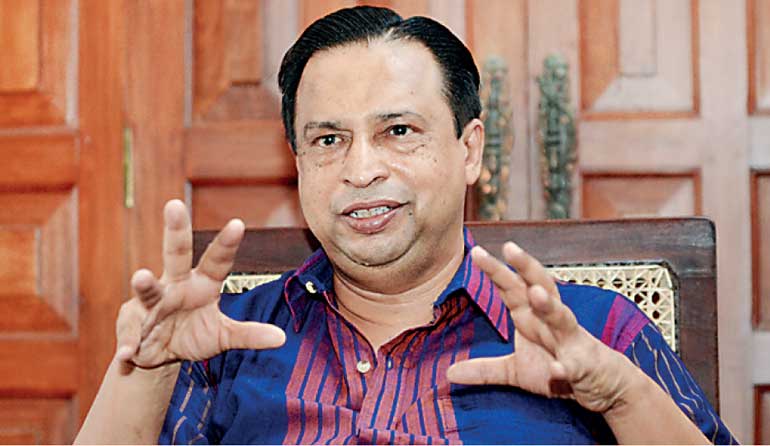Thursday Dec 18, 2025
Thursday Dec 18, 2025
Monday, 20 July 2015 00:00 - - {{hitsCtrl.values.hits}}
 RWCT Chairman Prof. Malik Ranasinghe – Pic by
RWCT Chairman Prof. Malik Ranasinghe – Pic by
Shehan Gunasekara
By Malik Gunatilleke
Birthed from the legacy of one of Sri Lanka’s most renowned inventors, the Ray Wijewardene Charitable Trust (RWCT) in collaboration with the Sri Lanka Inventors Commission and Commercial Bank has announced the second instalment of the ‘The Ray’ award.
Aimed at highlighting some of Sri Lanka’s pioneering new inventors, the RWCT has shortlisted five Presidential Award-winning inventors for The Ray award while an eminent independent panel of judges, would award a distinctive plaque and a citation to the winner, whilst Commercial Bank would award a credit line of Rs. 1 million to assist the winner to prepare his/her invention for commercialisation.
RWCT Chairman Prof. Malik Ranasinghe revealed his thoughts about the significance of the award, the role of the trust and the importance of fostering innovation in Sri Lanka.
“The RWCT is a charitable trust set up in the name of the late Ray Wijewardene. Its objective is to support and promote inventions and hopefully commercialisation in any field with a particular focus on the areas that he was interested in – engineering, sustainable agriculture, aeronautics and environment,” he said.
Ray Wijewardene
Ray Wijewardene had an extremely diverse personality. He was an Olympian athlete, an engineer, inventor and pioneer in sustainable agriculture.
In 1955, Wijewardene looked critically and scientifically at the farming practices prevailing at the time and invented the world’s first two-wheeled tractor calling it the Landmaster. In the years that followed, over 300,000 units were sold in 27 countries including Sri Lanka, the UK, Australia, the Philippines, Malaysia and Japan. Prof. Ranasinghe stated that the ultimate goal through the trust was to find the next Ray.
According to him, an invention is only a lab idea. Although these ideas can be demonstrated it doesn’t mean that it can be taken straight away to the market. The next step is innovation, which is the process by which you take the invention to the point where it can be widely demonstrated; the next stage is building a prototype and finally a business plan so that it can become a bankable project.
“The ‘inventor’ is an interesting personality who is constantly insecure of someone else stealing their ideas. They are very possessive about their ideas. Inventors are good at inventions but are poor at the rest of the processes that come afterwards in order to make their ideas into marketable projects,” he stated.
Supporting inventors
This is where the RWCT plays a major role in the invention’s timeline. Through the award, the RWCT aims to highlighting the inventors and their creations. In Sri Lanka, the Inventors Commission, which provides support to inventors, has various types of competitions and exhibitions each year. The highest award it gives out is the Presidential Award.
The RWCT then invites all the Presidential Award winners to apply for the Ray Award. The panel of judges chooses the inventions they feel have the potential to be commercialised and the inventors must then submit a completed questionnaire. Around 20 applicants applied for the Award this time and a final shortlist of five was announced. The panel of judges is chaired by Commissioner of the Sri Lanka Inventors Commission Deepal Sooriyarachchi while the award will be handed out at an event held on 24 August.
Prof. Ranasinghe also spoke about the last Ray Award winner, Indesri Karunathilaka who last year unveiled a prototype of his award-winning wave-less boat – a boat designed to minimise the damage caused to river banks. Along with the grant provided by Commercial Bank, Karunathilaka was able to take his idea and build an improved prototype which he was then able to unveil to the public.
Moving beyond initial innovation
The challenge however remains in encouraging new inventors to stick with their ideas and push on beyond the initial phases of innovation.
“Even at the University level, we have a lot of good ideas but at the end of the project, the students pass out, they get a job and good ideas die. There is no mechanism by which to support good ideas and we thought this was essential. Even on the national level, it’s the same story. Ideas are recognised but thereafter at the end of patent period, it dies a natural death. Simply because there is no support to take the idea further,” he said.
He claimed that the Government plays a huge role in fostering innovation within the public as well. While the private sector would most likely be interested after the project is proven to be profitable, it remains up to the state to provide the necessary support to allow inventors to push through with their ideas.
The Ray Wijewardene Charitable Trust was established in January 2011, to promote and sustain the vision and ideas of the legendary Ray Wijewardene. It aims to recognise and support innovations in sustainable agriculture, renewable energy, engineering and aeronautics.